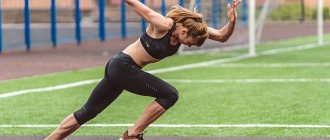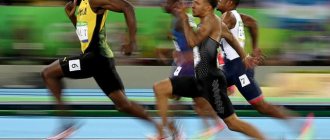How to run longer and faster? This question concerns all runners, regardless of their experience and level of training. Beginners aim to hit the 3k or 5k mark, serious runners aim for a specific time or pace. The goals are different, but they all depend on the same factor - endurance.
- What is endurance
- Types of endurance
- What factors affect endurance?
- Endurance training
What do we mean when we talk about running endurance? Most people are likely to call a person endurance who is able to run a long distance without stopping. Some more experienced runners will add that the time factor should also be taken into account.
Many of us, when we first started running, often set ourselves the goal of slightly improving our endurance. And usually such training took place according to the following two scenarios.
In the first case, people try to run as hard as possible for as long as possible each training session. There is no need to say that there is no question of any training program, correct running technique, or breathing. And it is not surprising that the results from such “training” leave much to be desired, and the jogging itself will not bring any pleasure. And everything will still end well if there is no injury!
Another option is for a person to start by jogging and gradually increase the distance covered. At some point, each of us awakens to the desire to run faster, or even more, and the idea arises to take part in some kind of half marathon or marathon. And after the first such race, which without proper preparation will most likely not turn out very well, a number of questions arise - what did I do wrong that I could not finish? Why am I running so slow? How can I become faster and more resilient?
To answer all these questions, it is advisable to have at least a basic understanding of how our body functions and what factors primarily determine results in long-distance running.
In this article, we tried to consider as simply and clearly as possible what the term “endurance” means and the most effective training to increase it.
On what factors does increasing endurance in running depend?
Two indicators allow you to increase endurance and running speed: maximum oxygen consumption (hereinafter referred to as MOC) and the lactate threshold (the period when acid accumulates in the muscles).
MIC indicator
The maximum oxygen consumption indicator shows how much oxygen is used while driving. It is easy to calculate: you need to subtract the amount of oxygen absorbed from the amount of oxygen exhaled.
Often athletes believe that VO2max characterizes the athlete's talent. This is not entirely true: VO2max describes the capacity of the aerobic system and depends on the processes during which oxygen from the environment reaches muscle mitochondria).
Lactate threshold
The lactate threshold shows the ability of the cardiovascular system to cope with stress. This indicator depends on the characteristics of the muscles.
Lactate (mammary gland) is a metabolic product that is produced during physical activity. Simply put, this is the level of fitness of the body to a certain load.
To increase the lactate threshold, individual classes are developed for each athlete. They allow you to improve your finishing time and develop running endurance.
Speed running technique
In speed running, not only the legs and the smooth push of the foot from the ground are important. An equally significant role is played by the positioning of the body, arms and even the head. By moving our hands we set our pace. Under no circumstances should they be pressed against the body. The arms move freely in tandem with the legs, bent at a right angle.
The movement is carried out with opposite hands and feet, so that the abdominal muscles do not contract and do not pinch the internal organs. The shoulder girdle should be relaxed. No need to look at your feet. Just straight ahead.
Another mistake is swinging the body after the arms. Thus, the athlete loses a lot of energy and gets tired quickly. Therefore, the body needs to be slightly tilted forward by 5-7 degrees and kept perpendicular to the ground or floor.
Foot placement is of great importance. It is necessary to ensure that it comes into contact with the surface as little as possible. The stride width should also be optimal for you, ensuring a smooth run.
It is best to practice the technique with a trainer. Since everyone has their own individual characteristics, which are best adjusted to avoid injury.
Types of endurance
To determine how to run for endurance, you first need to analyze your goals. Endurance comes in different types: general, special, speed, strength, aerobic and anaerobic.
- General, which allows you to perform cyclic physical work of average complexity (walking, jumping, swimming, pedaling).
- Special develops by repeating special exercises with high physical load (within 75-80% of the maximum load).
- Speed – the ability to run at maximum speed for a certain period of time. As a rule, movement at maximum speed does not last long: an athlete manages to overcome 100-200 meters in tens of seconds.
- Strength develops when moving on sand, snow, steps or hills, with the help of weights. Increasing running endurance is an essential part of training for sprinters. Power running is accompanied by increased calorie consumption, so it is popular among amateurs who are struggling with excess weight.
- Aerobic - the ability to continue moving at low speed for a long period. During this movement, the athlete's aerobic system uses oxygen to convert carbohydrates into energy sources.
- Anaerobic endurance develops under high loads. During the cross-country process, the body lacks oxygen and rapid muscle fatigue occurs. Anaerobic endurance is trained by athletes who overcome middle distances and this technique is called “running without oxygen.”
Video. Sprint. Running speed training.
Jumping training - plyometrics.
How to increase endurance?
How to become faster? Developing speed and explosiveness
How to increase endurance. Endurance exercises
- >
Jumping training - plyometrics.
A crowd favorite, Zina Rudenko shows an unusual jumping workout called plyometrics. Plyometrics was originally a sports technique using the impact method; in the modern sense - jumping training. Plyometrics are used by athletes to improve athletic performance that requires speed, quickness, and power.
- >
How to increase endurance?
Endurance is one of the most important qualities for effective training. How to increase it and how to become an endurance athlete? The answer is in this video.
- >
How to become faster? Developing speed and explosiveness
In this video, Alexey Nemtsov will tell you how to measure your speed and strength qualities and how to develop them. Theory and practice from the head coach of the crossfit club ARMA SMC.
- >
How to train endurance while running
There are many ways to develop running endurance. Each athlete chooses a technique individually, based on his goals and capabilities.
Interval running
The interval training method is similar to the wave-like nature of training, only the intensity changes during one cross-country. Such activities actively involve the respiratory and circulatory systems. Interval running can be different: it can turn into walking or overcoming step segments.
Endurance training in running with a transition to a step is popular among beginner athletes who are not able to cover long distances. You can create different intervals: beginner sprinters run for 2 minutes, and then move on to 30 seconds of walking.
It is not necessary to use this interval. You can take the length of the entire distance that you can run and divide it into several parts (for example, 2-3). After each part, you can go into a step for 1-3 minutes and continue moving.
Timed endurance running involves changing your pace every kilometer. For example, if you cover the first kilometer in 5 minutes, you need to run the next one in 20 seconds, and so on.
Cross-country with overcoming stepped segments involves alternating speed and rest time. For example, speed up for 45 seconds and slow down for 25 seconds. Such repetitions must be performed 2-3 times, and then change tactics: speed up for a minute and switch to slow running for 40 seconds.
Interval pyramid running
This development of endurance in running is used 2 months before the competition. The method is to gradually increase running time with acceleration. Moreover, the maximum acceleration occurs in the middle of the distance, and closer to the end of the cross-country it decreases again.
For such training it is necessary to use a stopwatch. It is advisable to increase the intensity carefully to avoid injury. It is necessary to plan your classes so that the training before the race is long and the rest time is minimal.
To increase your running endurance, you can train according to the following program:
- Warm-up 7-15 minutes;
- 35” (intense running), 60” (slowdown);
- 50” / 75”;
- 65” / 90”;
- 90” / 120”;
- 65” / 90”;
- 50” / 75”;
- 35” / 60”;
- Slow down for 15-20 minutes and go to a walk.
Endurance running workouts can be tailored to suit you by varying interval running times and slowing down.
Combined exercises
You can improve running endurance by combining different loads. For example, do not only jogging, but also perform other physical exercises. The result is increased running economy and more efficient use of oxygen.
Cycling is good for related training. It allows you to develop endurance while running. In winter, you can exercise on an exercise bike. Related exercises should be carried out carefully: first do light jogging and gradually increase the load.
Biking develops your lower body. Swimming is great for developing your upper body.
What are the benefits of endurance training and what does it develop?
At the physiological level, endurance training primarily develops central and peripheral aerobic components.
Central components (adaptation of organs and body systems):
- Stroke volume of the heart - the heart muscle becomes stronger and more voluminous, pulse zones decrease, pressure normalizes.
- Hemoglobin mass and blood volume - with systematic exercise, a positive increase in both indicators is observed.
Peripheral components (muscle fiber adaptation):
- The activity and volume of aerobic enzymes increases.
- The density of the capillary network increases.
- The amount of myoglobin increases, which helps transport oxygen from the blood to the muscles.
- Muscle fibers are recruited towards more economical ones.
Interestingly, the development of all of these components has a direct and inverse correlation with the development of endurance, i.e. They both develop with the help of endurance training, and their development stimulates the growth of endurance.
Photo: Charles Knox/Getty Images
Less Popular Methods to Increase Running Endurance
There are many ways to develop endurance while running, so professionals alternate between them. Popular methods are:
- Fellow Bart Yasso's method involves running 800 meters at the speed at which you plan to finish your first marathon. To run a marathon in 4 hours, you need to run 800 meters in 4 minutes. Bart Yasso's interval method: you can start with 4-5 repetitions and add intervals every week. It is also worth remembering that jogging must be inserted between each “active” segment. It must also last for a certain time (4 minutes).
- The Pierce technique is alternating loads. For example, on Monday you can run ≈ 5 km (12 intervals of 400 meters), on Wednesday - 5 km at a high speed, on Friday - 10 km at a slow pace.
- Noble's technique is to conduct one workout every 7 days. With each subsequent workout, you need to add jogging time (for example, +5 minutes).
- The plyometrics method is based on developing the body's capabilities through sudden movements (jumping every 10 meters). This technique allows you to quickly strengthen your muscles and become more resilient in running. It is advisable to use the technique only in special shoes with shock-absorbing soles to avoid knee injuries.
Which method is the most effective?
Each organism is unique, so it is difficult to say which method will bring the most benefit. We recommend trying each of them and monitoring the results. This way you can choose the optimal technique and developing endurance in long-distance running will take less time. The main thing is that the exercises bring benefits and do not harm the body.
In addition to choosing a training technique, it is advisable to maintain a sleep schedule, give up bad habits and fatty foods, and drink more purified water.
Additional methods
- In the cold season, go skiing, so you can improve not only endurance, but also coordination of movements.
- Go swimming. Swimming will help reduce the load on the spine and joints, while all muscles will work.
- Ride your bike. Regular cycling makes the muscles of the legs, buttocks and abs work.
While developing endurance, do not forget to control your heart rate.
After playing sports, you need to check your pulse. To measure, you can count the number of beats in 10 seconds and multiply the result by 6. The optimal heart rate is 130-145 beats per minute, depending on age.
Consider your level of training and permissible load. Be sure to alternate training with rest, avoid injuries and chronic fatigue. Building endurance is a long process with magical results.










